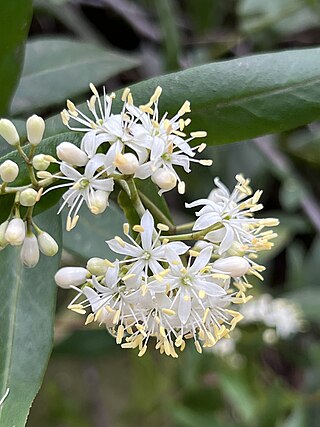
Leionema ambiens is a rare shrub growing in the Guyra district of New South Wales and Queensland, Australia. It has long stem clasping leaves and heads of white flowers in spring and early summer.

Leionema elatius, commonly known as tall phebalium, is a shrub species that is endemic to New South Wales and Queensland in Australia. It has glossy green, variably-shaped leaves and clusters of white-lemon flowers in spring.

Stackhousia monogyna, commonly known as creamy stackhousia or creamy candles, is a flowering plant in the family Celastraceae. It is a small multi-stemmed plant with narrow leaves and terminal spikes of white, cream or yellow flowers. It is a widespread species found in all states of Australia but not the Northern Territory.

Eremophila drummondii, commonly known as Drummond's eremophila, is a flowering plant in the figwort family, Scrophulariaceae and is endemic to the south-west of Western Australia. It is a variable shrub, usually with sticky branches and leaves, long, thin leaves and mauve or purple flowers in spring.

Arthrochilus irritabilis, commonly known as clubbed elbow orchid, is a flowering plant in the orchid family (Orchidaceae) and is endemic to Queensland. It has up to five leaves and up to thirty light greenish or reddish, insect-like flower with reddish, hair-like glands on its labellum. There is a single record of this species from Papua New Guinea.

Thelymitra × macmillanii, commonly called the red sun orchid or crimson sun orchid is a species of orchid that is endemic to south-eastern Australia. It has a single tapering, channelled leaf and up to five bright red, sometimes yellow flowers. It is a natural hybrid between T. antennifera and T. carnea or T. rubra.
Nervilia uniflora, commonly known as the red shield orchid, is a small terrestrial orchid found in northern Queensland. It has a single short-lived, pink or mauve flower. A dark green, heart-shaped leaf emerges at the base of the flowering stem after flowering.

Xanthosia atkinsoniana, is a small herb in the family Apiaceae. It grows in both New South Wales and Western Australia.

Brachyscome graminea, commonly known as grass daisy, is a perennial herb in the family Asteraceae and is endemic to Australia. It has mostly mauve-pink or purple daisy-like flowers and a yellow centre.
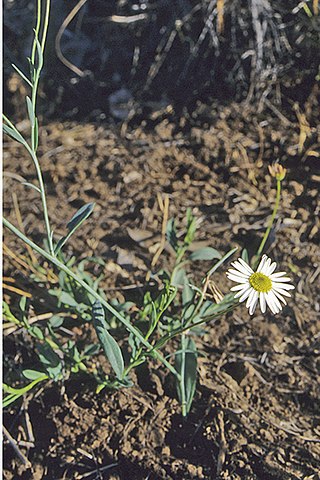
Brachyscome basaltica, commonly known as swamp daisy, is a perennial herb in the family Asteraceae and is endemic to Australia. It has mostly white daisy-like flowers and a yellow centre.

Bossiaea decumbens is a spreading, prostrate shrub in the pea family (Fabaceae), and is endemic to Victoria. It has alternate, variable shaped leaves and yellow pea flowers with red splotches from spring to late summer.

Goodenia eatoniana is a species of flowering plant in the family Goodeniaceae and is endemic to the extreme south-west of Western Australia. It is a perennial herb with lance-shaped leaves at the base of the plant, egg-shaped stem leaves, and racemes of blue flowers.

Goodenia heterochila, commonly known as serrated goodenia, is a species of flowering plant in the family Goodeniaceae and is endemic to arid areas of Australia. It is an erect or ascending perennial herb with lance-shaped to egg-shaped stem leaves with the narrow end towards the base, and racemes of yellow flowers with a brownish centre.
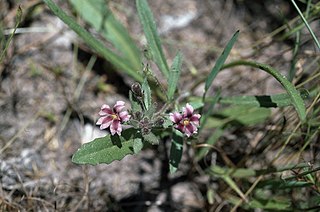
Goodenia purpurea is a species of flowering plant in the family Goodeniaceae and is endemic to the Northern Territory. It is an ascending herb with narrow oblong to lance-shaped leaves at the base of the plant, and racemes of purple flowers.
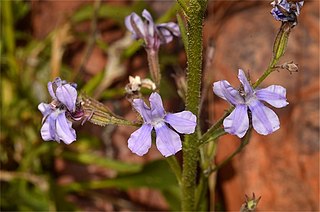
Goodenia ramelii is a species of flowering plant in the family Goodeniaceae and is endemic to central Australia. It is a perennial herb with toothed, elliptic leaves in a rosette at the base of the plant, and racemes of blue flowers.

Helichrysum calvertianum is a species of flowering plant in the family Asteraceae. It is a small subshrub with small crowded leaves and single white daisy-like flowers. It is endemic to the Southern Highlands in New South Wales.

Pimelea haematostachya, commonly known as pimelea poppy, is a species of flowering plant in the family Thymelaeaceae and is endemic to Queensland. It is a perennial herb with narrowly egg-shaped or narrowly elliptic leaves and heads of red flowers.
Pimelea sericostachya is a species of flowering plant in the family Thymelaeaceae and is endemic to Queensland. It is an undershrub or shrub with densely hairy young stems, narrowly elliptic leaves, and heads of yellow or pale yellow flowers.
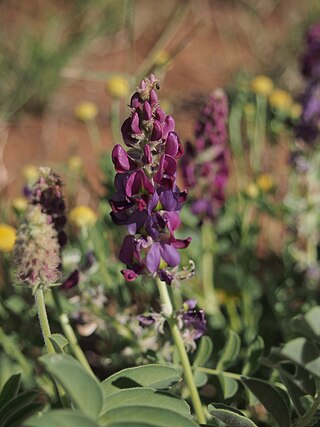
Swainsona canescens, commonly known as grey swainsona, is a flowering plant in the family Fabaceae. It is a small perennial herb with pink-purple or purple, yellow and green flowers and grows in Queensland, Western Australia and South Australia.

Podolepis hieracioides commonly known as long podolepis, is a flowering plant in the family Asteraceae and grows in New South Wales and Victoria. It is a small perennial with yellow flowers.




















